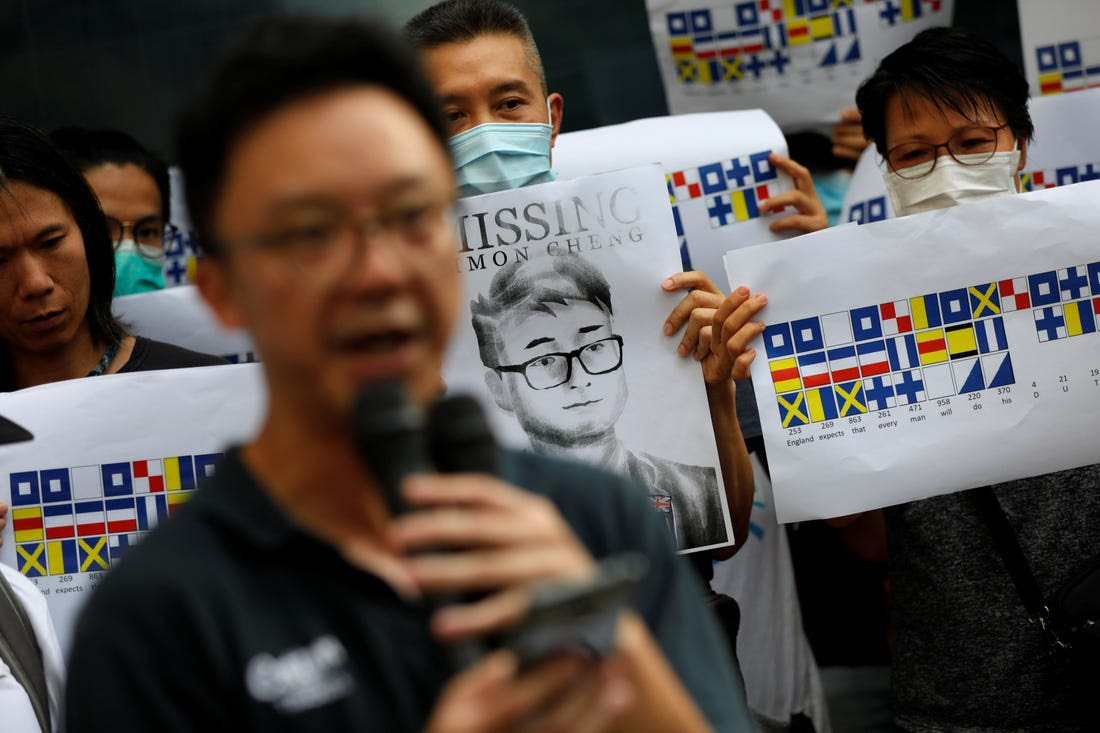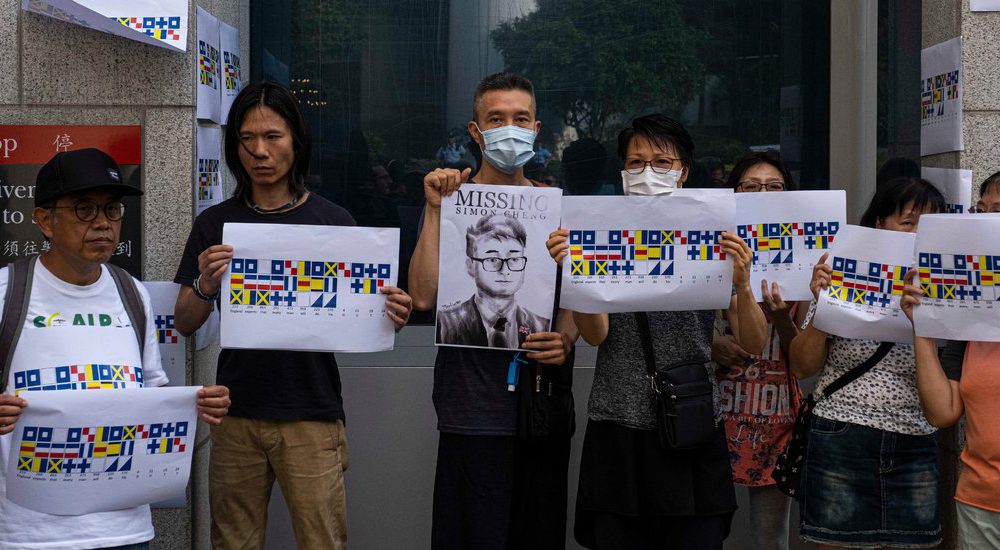Flag codes: another type of Hong Kong resistance writing
« previous post | next post »
This photograph is from a little over a year ago, when the former Hong Kong UK consulate worker Simon Cheng was kidnapped by the CCP government and taken to China where he was tortured and forced to make a "confession":
Recently, this photograph has begun to circulate again, and people have been asking me how to interpret the symbols.
I immediately took the symbols to be based on the International Code of Signals, but couldn't readily interpret the message with the list of international flags and pennants available here. Some of the flags in the photograph do not appear in that list, such as the white and blue one divided on a diagonal. (I suppose it means "end of message", but why is it repeated? For emphasis?) So there must be some other list of extended symbols, or …? It should be noted that there are single-letter signals and multiple-letter signals up to five-letter codes for every prominent maritime location in the world. Even the single-letter signals may have complex meanings. For instance, the flag for "A" is:

That is pronounced "Alfa [ˈal.fa]". As a single flag it means "I have a diver down; keep well clear at slow speed." As a numeric complement, it signifies azimuth or bearing.
The composition and interpretation of messages using the International Code of Signals is extremely complicated. I learned Morse code as a Boy Scout, but that was much simpler than this type of flag code.
Here is a closeup that shows what is printed in English underneath (click to embiggen):

(Source)
The symbols need to be read as columns of numbers, producing mainly 3-digit numbers that represent words.
One column on the right is only one symbol, the number 4, which stands for “D”, the 4th letter of the alphabet, then there are a couple of double symbols for “U” (21) and “T” (20) and “Y” (25).
I’m not sure where the match between 3-digit numbers and words comes from.
Be that as it may, the message is: "England expects that every man will do his duty". That was the immortal "signal sent by Vice-Admiral of the Royal Navy Horatio Nelson, 1st Viscount Nelson from his flagship HMS Victory as the Battle of Trafalgar was about to commence on 21 October 1805". (source)
Think about it.
Selected readings
- "National Security Law eclipses Hong Kong" (6/2/20)
- "The difference between deformation and devoidness" (9/5/20)
- "Handfoot" (7/31/20)
- "Better said in Cantonese" (7/4/20)
- "Hong Kong: language, art, and resistance" (5/24/20)
- "Chinese characters written in Greek letters" (7/12/20)
- "GFHG, SDGM" (7/7/20)
- "Uppercase and lowercase letters in Cantonese Romanization" (5/28/20)
- "Hong Kong protests: 'recover' or 'liberate'" (11/3/19)
- "Hong Kong protesters messing with the characters" (7/28/19)
- "Hong Kong protesters messing with the characters, part 2" (9/1/19)
- "I'm strikin' it" (8/30/19)
- "ChiNAZI" (8/27/19)
- "Cockroach protesters" (8/23/19)
- "Cryptic, allusive messages from Hong Kong's wealthiest tycoon" (8/18/19)
- "Simplified characters in Hong Kong police newsletter" (8/15/19)
- "'Come, comrades, over there!'" (8/9/19)
- "HK protesters' 'sign language'" (8/6/19)
- "Go protest on Causeway Road" (8/5/19)
- "Graffiti correction" (7/26/19)
- "Hong Kong anti-China graffiti" (7/26/19)
- "The enigma of the black hands" (7/25/19)
- "Ich bin ein Hongkonger" (7/18/19)
- "'People's Re-fu*king of Chee-na'" (10/12/16)
- "A Sanskrit tattoo in Hong Kong" (10/4/16)
- "Hong Kong protest puns" (6/20/19) — featuring an ingenious new character ostensibly meaning "Freedom, Hi!", but with a vulgar subtext
- "Cantonese protest slogans" (10/26/14)
- "'Cantonese' song" (10/24/14)
- "The umbrella in Hong Kong" (10/19/14)
- "Translating the Umbrella Revolution" (10/3/14)
- "The backstory to seven of the most popular protest slogans in Hong Kong's Umbrella Movement" (10/23/14)
- "Hong Kong interlingual contrast" (11/26/14)
- "New Cantonese word" (12/8/14)
- "Thick toast: another new Cantonese pun " (12/11/14)
- "The perils of '7' and '9' in Cantonese " (9/28/16)
- "A new polysyllabic character" (4/3/16)
- "Polysyllabic characters in Chinese writing " (8/2/11)
- "Polysyllabic characters revisited " (6/18/15)
- "'HKers add oil'" (8/3/19)
- "'Add oil'" (9/13/16)
- "'Add oil' is now English" (10/18/18)
- "Comrades, 'hike up your skirts for a hard shag'" (7/23/17)
- "Non-translation" (7/24/16) — in the comments
- "'Go Hong Kong!'" (6/12/19) — ambigram
- "'Add oil,' Kongish!" (9/1/19) — with references to previous posts on this subject
- "Vocabulary of Hong Kong protest slogans and new characters" (9/1/19)
- "Loose Romanization for Cantonese" (9/21/19)
- "Women's Romanization for Hong Kong" (9/17/19)
- "Hong Kong protesters' argot" (9/7/19) — includes a long list of relevant posts, including many that are not listed here
- "The Infinite Heartbreak of Loving Hong Kong: As China moves to impose a law that would criminalize dissent, Hong Kongers are facing a dark new era". By Wilfred Chan, The Nation (5/23/20)
[h.t. June Teufel Dreyer; thanks to Bob Bauer, to Chris Fraser, and thanks to James St. André and his friend Howard, the code sleuth]

Vilinthril said,
October 6, 2020 @ 2:18 am
The numeric code is from the Telegraphic Signals of Marine Vocabulary.
https://en.wikipedia.org/wiki/England_expects_that_every_man_will_do_his_duty#cite_ref-NS_3-1
Victor Mair said,
October 6, 2020 @ 6:55 am
From James St. André:
I tracked down a copy of Popham’s Telegraphic Signals; Or Marine Vocabulary (1803) on the internet archive, where you can see what words he thought were essential.
https://archive.org/details/bub_gb_qxZEAAAAYAAJ/page/n23/mode/2up
Vilinthril said,
October 6, 2020 @ 9:38 am
Oh, interesting that the title seems to be almost universally wrong in many sources. Or is there some variation on that in the released editions of the book?
ajay said,
October 7, 2020 @ 4:49 am
Keep an eye out for people waving a white flag with a blue cross, and a horizontal tricolour blue-white-red. This does not mean the protesters support Finland and the Netherlands; it is Nelson's last signal, "16", or "engage the enemy more closely".
ajay said,
October 7, 2020 @ 5:00 am
The ICOS is fascinating, especially in the detail it gives to medical signals. In theory a (for example) Brazilian ship with a monoglot Brazilian crew could request and receive medical advice from a similarly monoglot Russian ship, simply by hoisting flags (or sending Morse signals) along the lines of:
MAA I request urgent medical advice
MAJ27 I have a male aged 27 years
MDL Severe pain..
MBG22 …in right lower abdomen…
MDO …increased by hand pressure…
MEM …with vomiting. (An easy one to remember – EMesis)
To which the Russian might reply:
MQF8 My probable diagnosis is appendicitis
MVA The condition is serious
MVP You should land your patient at the earliest opportunity
Philip Taylor said,
October 7, 2020 @ 5:51 am
Whilst the patient would probably devoutly hope that the Russian did not respond with 2059 — "I can cut them out without any assistance".
ajay said,
October 7, 2020 @ 10:07 am
Some friends and I spent a little time a few years ago devising a list of "ICOS Messages Which Could Be Useful In A Nightclub"
FO1: "I will stay close to you during the night"
Q: "I am free of infectious disease"
X: "Stop carrying out your intentions and wait for my signal"
TE: "I am engaged in trawling"
LS: "The bar is dangerous here"
MCX MLE: "Patient is delirious and has consumed much alcohol"
CL: "I offered assistance but it was declined"
BB2: "You may alight on my deck: I am ready to receive you amidships"
and various others which now escape my memory.